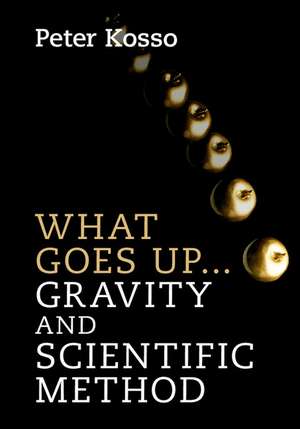What Goes Up... Gravity and Scientific Method
Autor Peter Kossoen Limba Engleză Hardback – 19 ian 2017
Preț: 240.00 lei
Nou
Puncte Express: 360
Preț estimativ în valută:
45.93€ • 49.11$ • 38.29£
45.93€ • 49.11$ • 38.29£
Carte indisponibilă temporar
Doresc să fiu notificat când acest titlu va fi disponibil:
Se trimite...
Preluare comenzi: 021 569.72.76
Specificații
ISBN-13: 9781107129856
ISBN-10: 1107129850
Pagini: 232
Ilustrații: 56 b/w illus. 2 tables
Dimensiuni: 178 x 254 x 15 mm
Greutate: 0.65 kg
Editura: Cambridge University Press
Colecția Cambridge University Press
Locul publicării:New York, United States
ISBN-10: 1107129850
Pagini: 232
Ilustrații: 56 b/w illus. 2 tables
Dimensiuni: 178 x 254 x 15 mm
Greutate: 0.65 kg
Editura: Cambridge University Press
Colecția Cambridge University Press
Locul publicării:New York, United States
Cuprins
Preface; 1. Introduction; 2. Forces and fields; 3. Basic Newtonian theory; 4. Gravity before Newton; 5. Early modern astronomy; 6. Connecting physics and astronomy; 7. Connecting kinematics and dynamics; 8. Testing the Newtonian theory; 9. Challenging the Newtonian theory; 10. Geometry and equivalence; 11. The general theory of relativity; 12. Testing the general theory of relativity; 13. Using the theory to explore the universe; 14. Dark matter; 15. The structure of scientific knowledge; Glossary; Bibliography.
Recenzii
'In Kosso's most recent work, the philosopher and physicist exhibits precision in language and thought. In a sense, What Goes Up is three works in one. A history of physics is intertwined with a non-mathematical conceptual physics text. Arising out of these two comes a philosophy of physics glue that binds the first two together. The evolution of one's 'understanding of gravity' … is used as the narrative, leading the reader from cover to cover. Philosophically, Kosso … helps the reader appreciate the scientific method as it comes to maturity out of a cooperation between observation and theory. He discusses such topics as the 'distinction between description and explanation', instrumentalism, and causal mechanisms. Especially easy to follow is his conceptual presentation on the metric and the manner in which the principle of equivalence leads to the gravitational red shift and the slowing of clocks - both normally difficult topics in general relativity.' J. F. Burkhart, CHOICE
'I would say that it is about how scientific knowledge develops over time, using the historical evolution of our understanding of gravity as a guiding thread. … What Goes Up … is certainly an excellent guide to the science of gravity and its historical evolution, from the standpoint of a 21st century expert. It is interesting, for instance, to compare the 'theories of principle' of Aristotle and Einstein with the 'constructive theory' of Newton. … The text is well written and accessible. My teenage children learned about non-Euclidean geometry from figures in the book and were intrigued by the thought that gravity is not a force field but rather a metric field, which determines the straightest possible lines (geodesics) between two points in space-time.' Carlos Lourenço, CERN Courier
'I would say that it is about how scientific knowledge develops over time, using the historical evolution of our understanding of gravity as a guiding thread. … What Goes Up … is certainly an excellent guide to the science of gravity and its historical evolution, from the standpoint of a 21st century expert. It is interesting, for instance, to compare the 'theories of principle' of Aristotle and Einstein with the 'constructive theory' of Newton. … The text is well written and accessible. My teenage children learned about non-Euclidean geometry from figures in the book and were intrigued by the thought that gravity is not a force field but rather a metric field, which determines the straightest possible lines (geodesics) between two points in space-time.' Carlos Lourenço, CERN Courier
Notă biografică
Descriere
This book explores the history of gravity, from Aristotle to Einstein, as a detailed case study for explaining scientific method for non-specialists.
